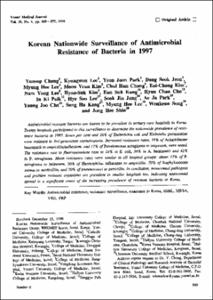KUMEL Repository
1. Journal Papers (연구논문)
1. School of Medicine (의과대학)
Dept. of Laboratory Medicine (진단검사의학)
Korean Nationwide Surveillance of Antimicrobial Resistance of bacteria in 1997
- Keimyung Author(s)
- Jeon, Dong Seok
- Department
- Dept. of Laboratory Medicine (진단검사의학)
- Journal Title
- Yonsei Medical Journal
- Issued Date
- 1998
- Volume
- 39
- Issue
- 6
- Abstract
- Antimicrobial-resistant bacteria are known to be prevalent in tertiary-care hospitals in Korea. Twenty hospitals participated to this surveillance to determine the nationwide prevalence of resistance bacteria in 1997. Seven per cent and 26% of Escherichia coli and Klebsiella pneumoniae were resistant to 3rd-generation cephalosporin. Increased resistance rates, 19% of Acinetobacter baumannii to ampicillin/sulbactam, and 17% of Pseudomonas aeruginoa to imipenem, were noted. The resistance rate to fluoroquinolone rose to 24% in E. coli, 56% in A. baumannii and 42% in P. aeruginosa. Mean resistance rates were similar in all hospital groups: about 17% of P. aeruginosa to imipenem, 50% of Haemophilus influenzae to ampicillin, 70% of Staphylococcus aureus to methicillin, and 70% of pneumococci to penicillin. In conclusion, nosocomial pathogens and problem resistant organisms are prevalent in smaller hospitals too, indicating nosocomial spread is a significant cause of the increasing prevalence of resistant bacteria in Korea.
- Keimyung Author(s)(Kor)
- 전동석
- Publisher
- School of Medicine
- Citation
- Yun Sop Chong et al. (1998). Korean Nationwide Surveillance of Antimicrobial Resistance of bacteria in 1997. Yonsei Medical Journal, 39(6), 569–577. doi: 10.3349/ymj.1998.39.6.569
- Type
- Article
- ISSN
- 0513-5796
- Appears in Collections:
- 1. School of Medicine (의과대학) > Dept. of Laboratory Medicine (진단검사의학)
- 파일 목록
-
-
Download
 oak-bbb-00030.pdf
기타 데이터 / 938.92 kB / Adobe PDF
oak-bbb-00030.pdf
기타 데이터 / 938.92 kB / Adobe PDF
-
Items in Repository are protected by copyright, with all rights reserved, unless otherwise indicated.